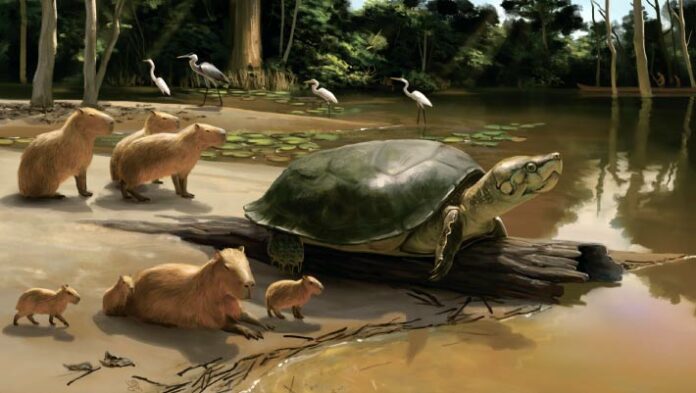Peltocephalus maturin possibly reached about 1.8 m (5.9 feet) in carapace length and is among the largest freshwater turtles ever found. This finding presents the latest known occurrence of giant freshwater turtles, hinting at coexistence with early human inhabitants in the Amazon.
The newly-discovered turtle species lived in what is now Brazil during the Late Pleistocene, between 40,000 and 9,000 years ago.
Named Peltocephalus maturin, the ancient animal possibly reached about 1.8 m in carapace length.
“This is very surprising because freshwater turtles — in contrast to their terrestrial and marine relatives — rarely have such gigantic forms and the youngest giant fossils known to date come from Miocene deposits,” said Dr. Gabriel Ferreira, a paleontologist with the Senckenberg Center for Human Evolution and Palaeoenvironment at the University of Tübingen.
“With a maximum carapace length of 1.4 m (4.6 feet), the Asian narrow-headed softshell turtle (Chitra chitra) together with the approximately 1.1-m- (3.6-foot) long South American river turtle (Podocnemis expansa) are some of the largest freshwater turtles alive today.”
“In the past, we only knew of a few turtles living in freshwaters that had carapace length of more than 1.5 m (4.9 feet),” he added.
“Such large animals are most recently known primarily from the Miocene, the period around 23 to 5 million years ago.”
The massive partial lower jaw of Peltocephalus maturin came from the Rio Madeira Formation.
The specimen was collected by gold miners at the site known as Taquaras Quarry in Porto Velho, the Brazilian Amazon.
Morphological and phylogenetic analyses of the fossil revealed close affinities to living Amazonian species and suggested an omnivorous diet.
“Peltocephalus maturin is the youngest known occurrence of giant freshwater turtles and suggests a coexistence of the ancient species with early human inhabitants in the Amazon region,” the paleontologists said.
“People settled in the Amazon region around 12,600 years ago. We also know that large tortoises have been on the diet of hominins since the Paleolithic.”
“Whether freshwater turtles, which are much more difficult to catch due to their agility, were also eaten by early humans and whether Peltocephalus maturin — together with the South American megafauna — fell victim to human expansion is still unclear.”
“Here we need more data from the Late Pleistocene and Early Holocene deposits of the Amazon Basin,” Dr. Ferreira said.
The discovery of Peltocephalus maturin is reported in a paper in the journal Biology Letters.
_____
G.S. Ferreira et al. 2024. The latest freshwater giants: a new Peltocephalus (Pleurodira: Podocnemididae) turtle from the Late Pleistocene of the Brazilian Amazon. Biol. Lett 20 (3): 20240010; doi: 10.1098/rsbl.2024.0010


